TOYOTA COROLLA HATCHBACK 2022 Owners Manual (in English)
Manufacturer: TOYOTA, Model Year: 2022, Model line: COROLLA HATCHBACK, Model: TOYOTA COROLLA HATCHBACK 2022Pages: 758, PDF Size: 155.26 MB
Page 531 of 758
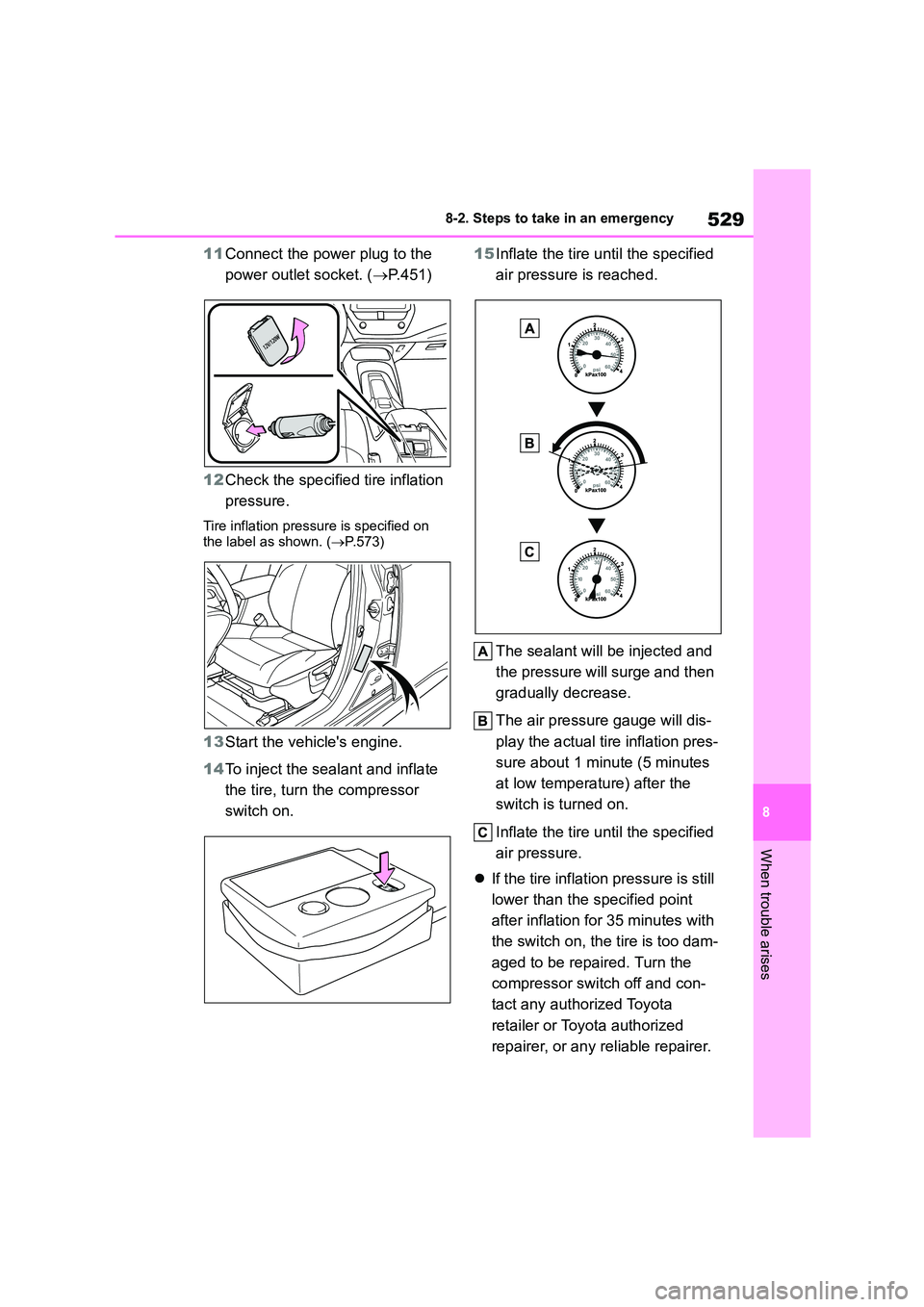
529
8
8-2. Steps to take in an emergency
When trouble arises
11 Connect the power plug to the
power outlet socket. ( P.451)
12 Check the specified tire inflation
pressure.
Tire inflation pressure is specified on the label as shown. ( P.573)
13Start the vehicle's engine.
14 To inject the sealant and inflate
the tire, turn the compressor
switch on.
15 Inflate the tire until the specified
air pressure is reached.
The sealant will be injected and
the pressure will surge and then
gradually decrease.
The air pressure gauge will dis-
play the actual tire inflation pres-
sure about 1 minute (5 minutes
at low temperature) after the
switch is turned on.
Inflate the tire until the specified
air pressure.
If the tire inflation pressure is still
lower than the specified point
after inflation for 35 minutes with
the switch on, the tire is too dam-
aged to be repaired. Turn the
compressor switch off and con-
tact any authorized Toyota
retailer or Toyota authorized
repairer, or any reliable repairer.
Page 532 of 758
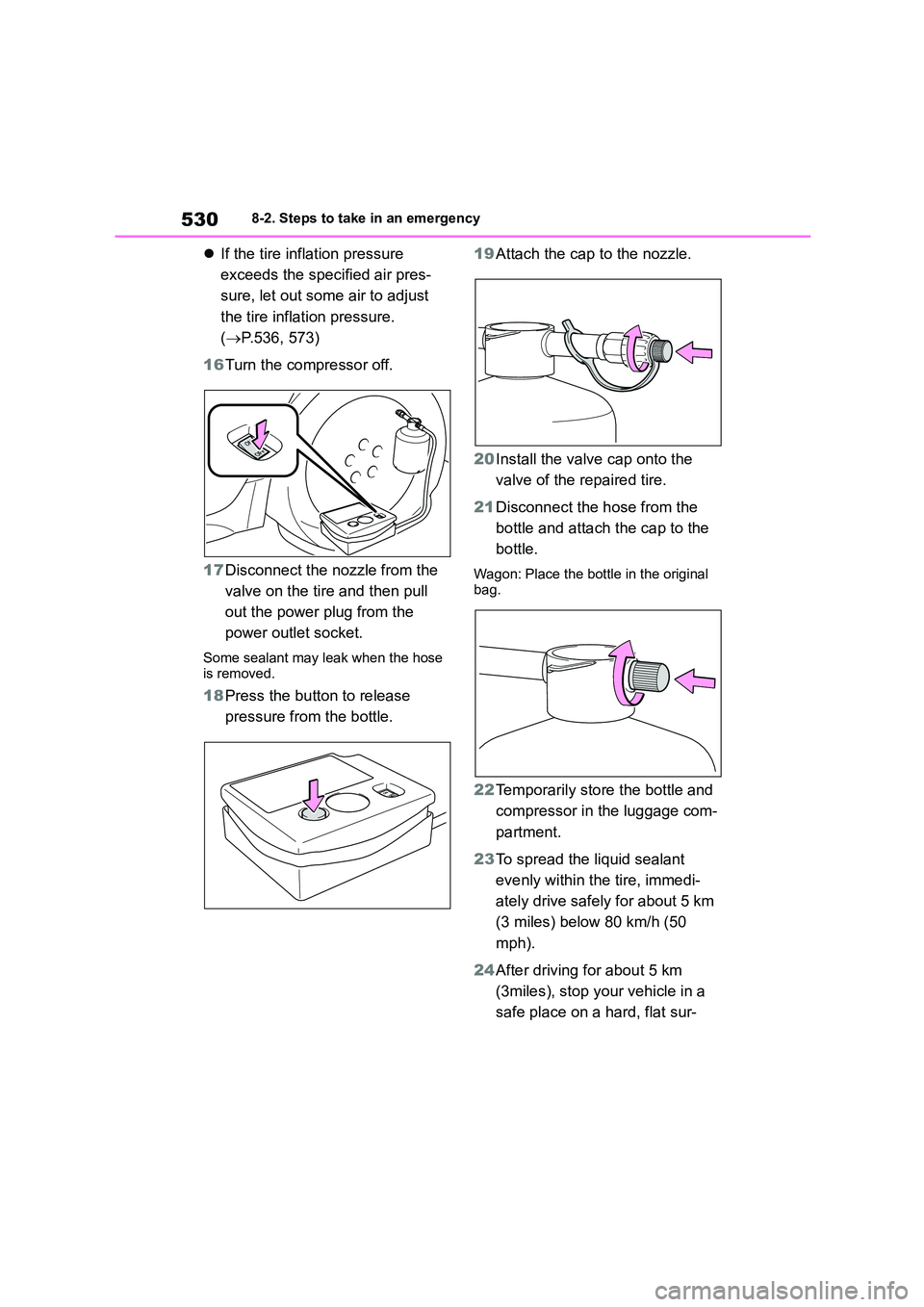
5308-2. Steps to take in an emergency
If the tire inflation pressure
exceeds the specified air pres-
sure, let out some air to adjust
the tire inflation pressure.
( P.536, 573)
16 Turn the compressor off.
17 Disconnect the nozzle from the
valve on the tire and then pull
out the power plug from the
power outlet socket.
Some sealant may leak when the hose
is removed.
18 Press the button to release
pressure from the bottle.
19 Attach the cap to the nozzle.
20 Install the valve cap onto the
valve of the repaired tire.
21 Disconnect the hose from the
bottle and attach the cap to the
bottle.
Wagon: Place the bottle in the original
bag.
22 Temporarily store the bottle and
compressor in the luggage com-
partment.
23 To spread the liquid sealant
evenly within the tire, immedi-
ately drive safely for about 5 km
(3 miles) below 80 km/h (50
mph).
24 After driving for about 5 km
(3miles), stop your vehicle in a
safe place on a hard, flat sur-
Page 533 of 758
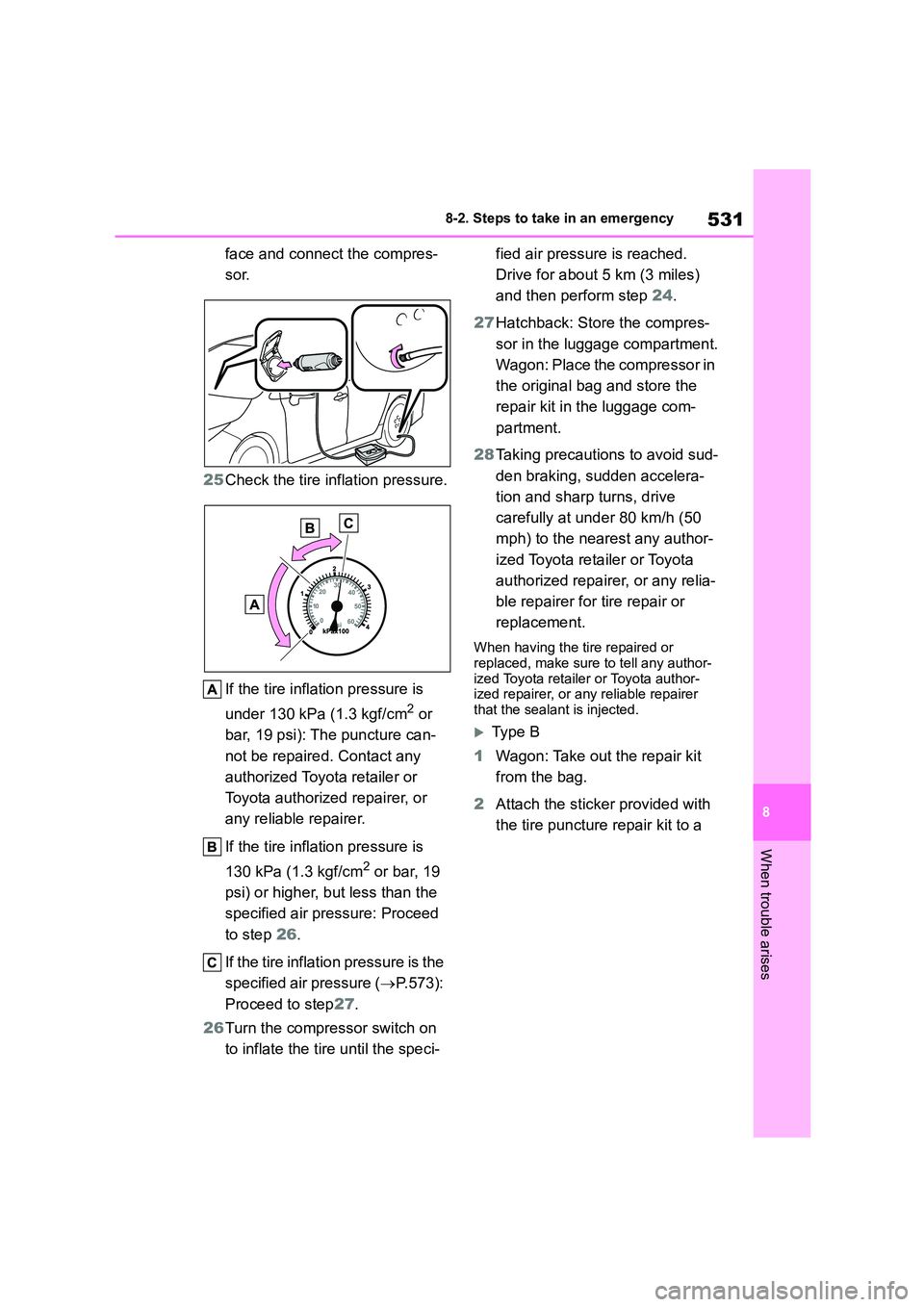
531
8
8-2. Steps to take in an emergency
When trouble arises
face and connect the compres-
sor.
25 Check the tire inflation pressure.
If the tire inflat ion pressure is
under 130 kPa (1.3 kgf/cm2 or
bar, 19 psi): The puncture can-
not be repaired. Contact any
authorized Toyota retailer or
Toyota authorized repairer, or
any reliable repairer.
If the tire inflat ion pressure is
130 kPa (1.3 kgf/cm2 or bar, 19
psi) or higher, but less than the
specified air pressure: Proceed
to step 26.
If the tire inflatio n pressure is the
specified air pressure ( P.573):
Proceed to step 27.
26 Turn the compressor switch on
to inflate the tire until the speci-
fied air pressure is reached.
Drive for about 5 km (3 miles)
and then perform step 24.
27 Hatchback: Store the compres-
sor in the luggage compartment.
Wagon: Place the compressor in
the original bag and store the
repair kit in the luggage com-
partment.
28 Taking precautions to avoid sud-
den braking, sudden accelera-
tion and sharp turns, drive
carefully at under 80 km/h (50
mph) to the nearest any author-
ized Toyota reta iler or Toyota
authorized repairer, or any relia-
ble repairer for tire repair or
replacement.
When having the tire repaired or
replaced, make sure to tell any author-
ized Toyota retailer or Toyota author- ized repairer, or any reliable repairer
that the sealant is injected.
Ty p e B
1 Wagon: Take out the repair kit
from the bag.
2 Attach the sticker provided with
the tire puncture repair kit to a
Page 534 of 758
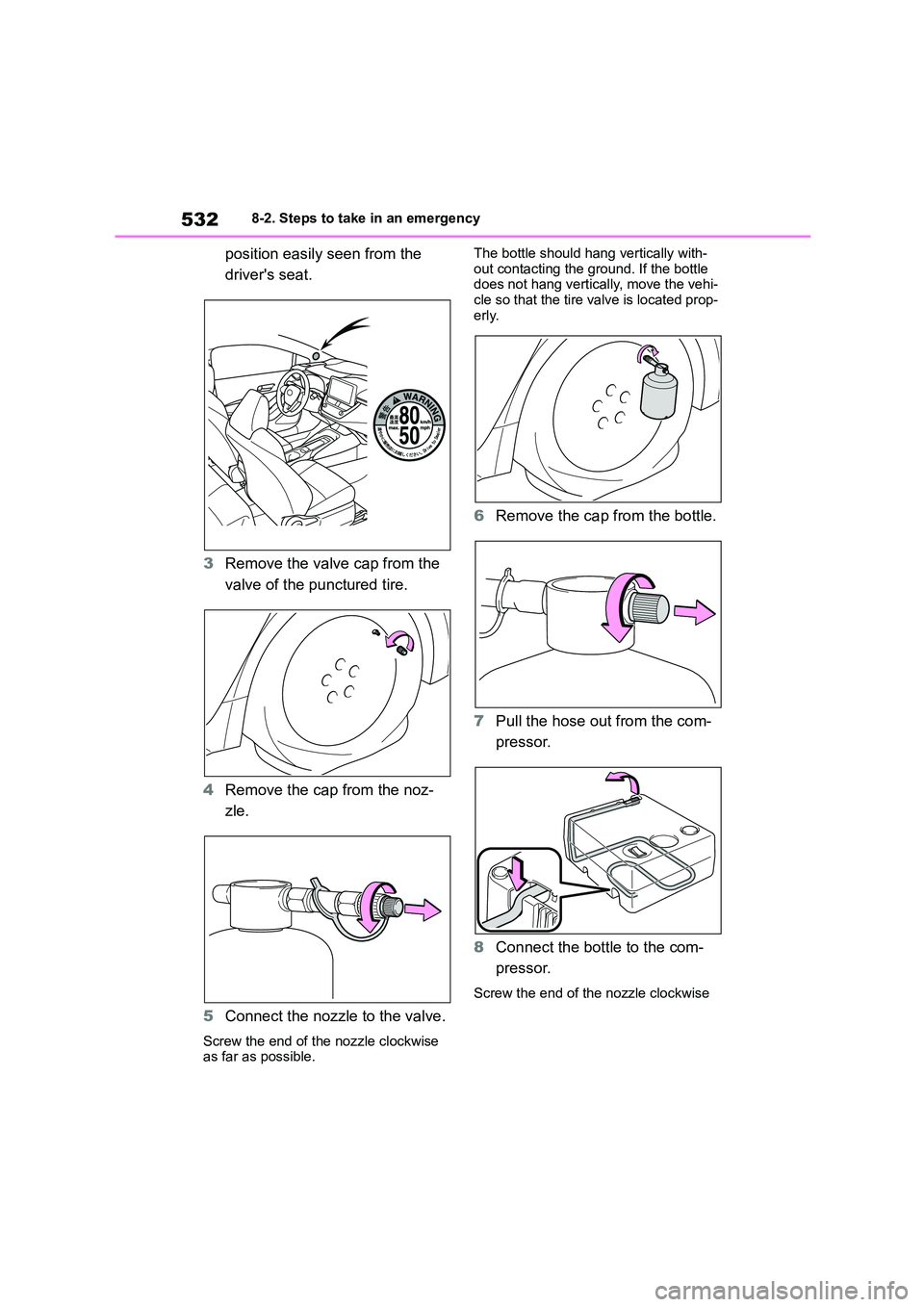
5328-2. Steps to take in an emergency
position easily seen from the
driver's seat.
3 Remove the valve cap from the
valve of the punctured tire.
4 Remove the cap from the noz-
zle.
5 Connect the nozzle to the valve.
Screw the end of the nozzle clockwise as far as possible.
The bottle should hang vertically with-
out contacting the ground. If the bottle does not hang vertically, move the vehi-
cle so that the tire valve is located prop-
erly.
6 Remove the cap from the bottle.
7 Pull the hose out from the com-
pressor.
8 Connect the bottle to the com-
pressor.
Screw the end of the nozzle clockwise
Page 535 of 758
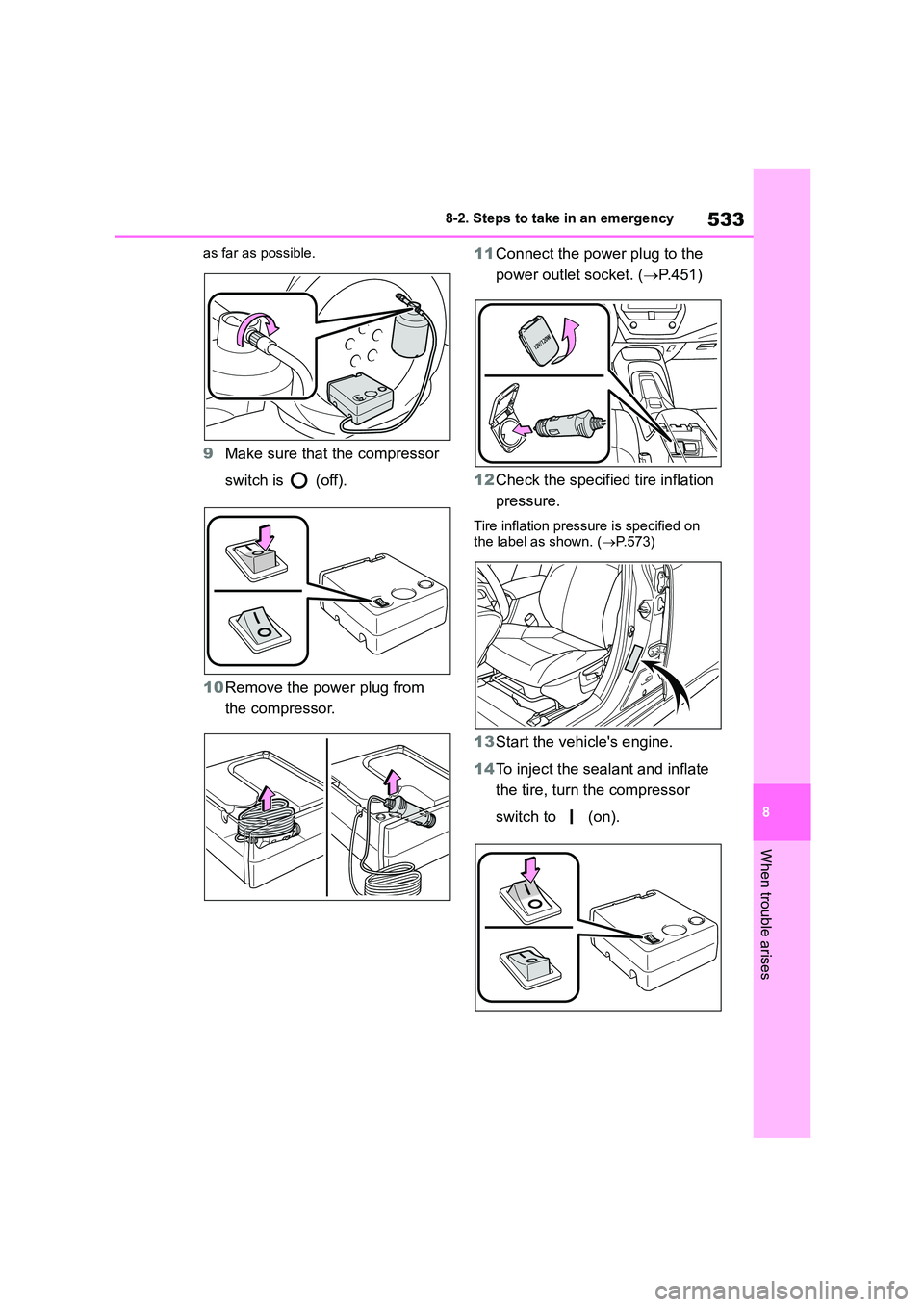
533
8
8-2. Steps to take in an emergency
When trouble arises
as far as possible.
9 Make sure that the compressor
switch is (off).
10 Remove the power plug from
the compressor.
11 Connect the power plug to the
power outlet socket. ( P.451)
12 Check the specified tire inflation
pressure.
Tire inflation pressure is specified on the label as shown. ( P.573)
13Start the vehicle's engine.
14 To inject the sealant and inflate
the tire, turn the compressor
switch to (on).
Page 536 of 758
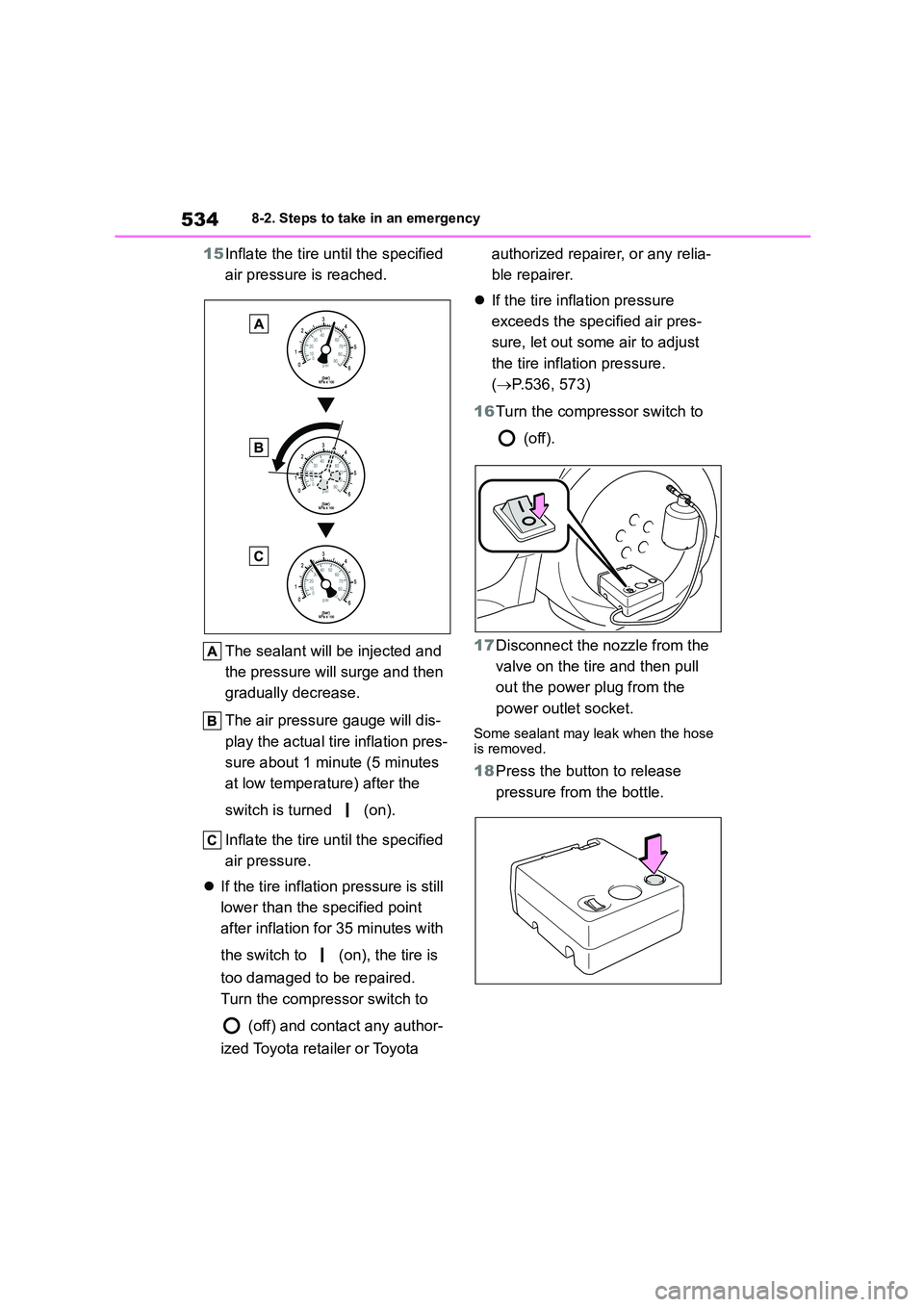
5348-2. Steps to take in an emergency
15Inflate the tire until the specified
air pressure is reached.
The sealant will be injected and
the pressure will surge and then
gradually decrease.
The air pressure gauge will dis-
play the actual tire inflation pres-
sure about 1 minute (5 minutes
at low temperature) after the
switch is turned (on).
Inflate the tire until the specified
air pressure.
If the tire inflation pressure is still
lower than the specified point
after inflation for 35 minutes with
the switch to (on), the tire is
too damaged to be repaired.
Turn the compressor switch to
(off) and contact any author-
ized Toyota reta iler or Toyota
authorized repairer, or any relia-
ble repairer.
If the tire inflation pressure
exceeds the specified air pres-
sure, let out some air to adjust
the tire inflation pressure.
( P.536, 573)
16 Turn the compressor switch to
(off).
17 Disconnect the nozzle from the
valve on the tire and then pull
out the power plug from the
power outlet socket.
Some sealant may leak when the hose is removed.
18 Press the button to release
pressure from the bottle.
Page 537 of 758
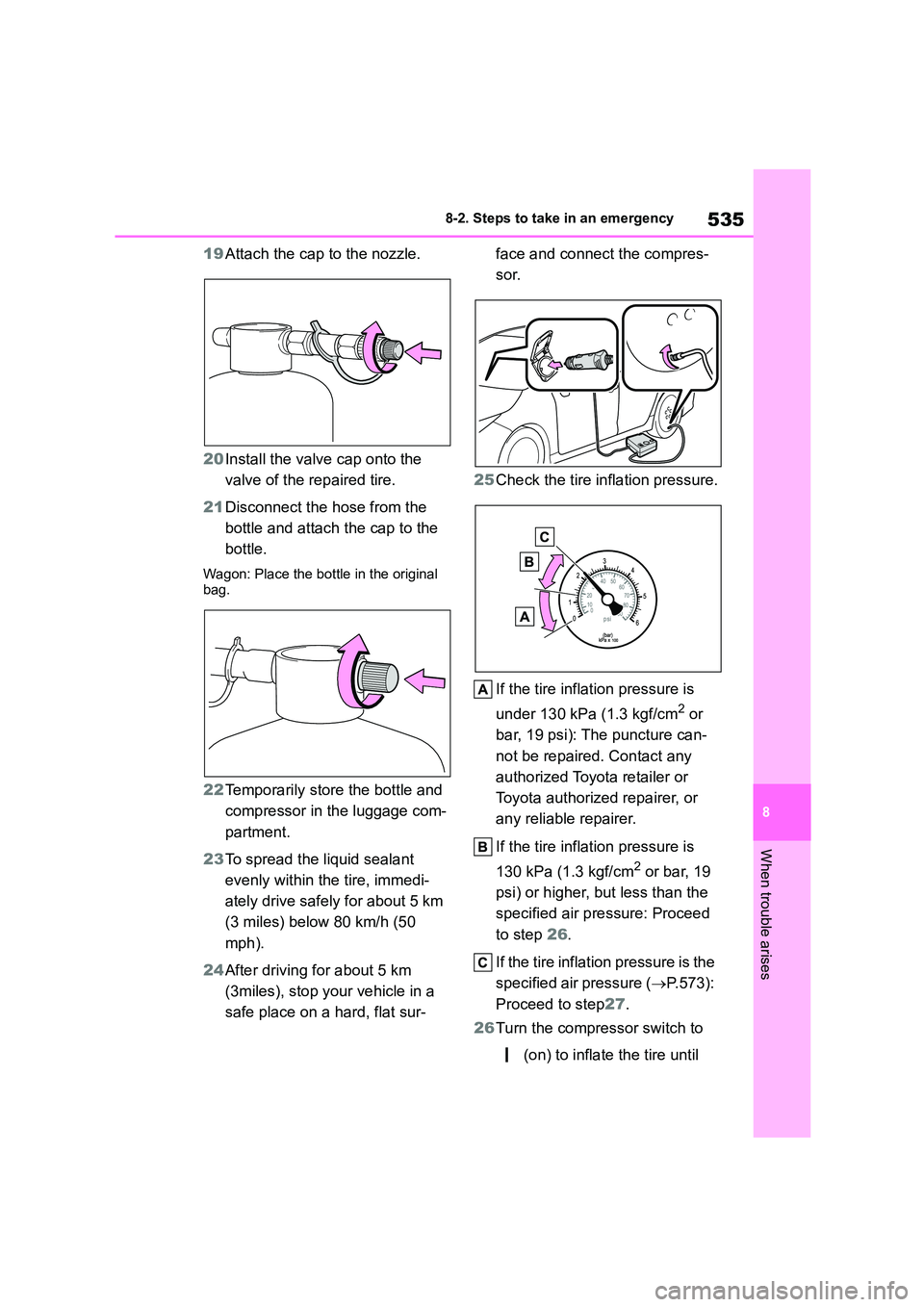
535
8
8-2. Steps to take in an emergency
When trouble arises
19 Attach the cap to the nozzle.
20 Install the valve cap onto the
valve of the repaired tire.
21 Disconnect the hose from the
bottle and attach the cap to the
bottle.
Wagon: Place the bottle in the original
bag.
22 Temporarily store the bottle and
compressor in the luggage com-
partment.
23 To spread the liquid sealant
evenly within the tire, immedi-
ately drive safely for about 5 km
(3 miles) below 80 km/h (50
mph).
24 After driving for about 5 km
(3miles), stop your vehicle in a
safe place on a hard, flat sur-
face and connect the compres-
sor.
25 Check the tire inflation pressure.
If the tire inflation pressure is
under 130 kPa (1.3 kgf/cm2 or
bar, 19 psi): The puncture can-
not be repaired. Contact any
authorized Toyota retailer or
Toyota authorized repairer, or
any reliable repairer.
If the tire inflation pressure is
130 kPa (1.3 kgf/cm2 or bar, 19
psi) or higher, but less than the
specified air pressure: Proceed
to step 26.
If the tire inflation pressure is the
specified air pressure ( P.573):
Proceed to step 27.
26 Turn the compressor switch to
(on) to inflate the tire until
Page 538 of 758
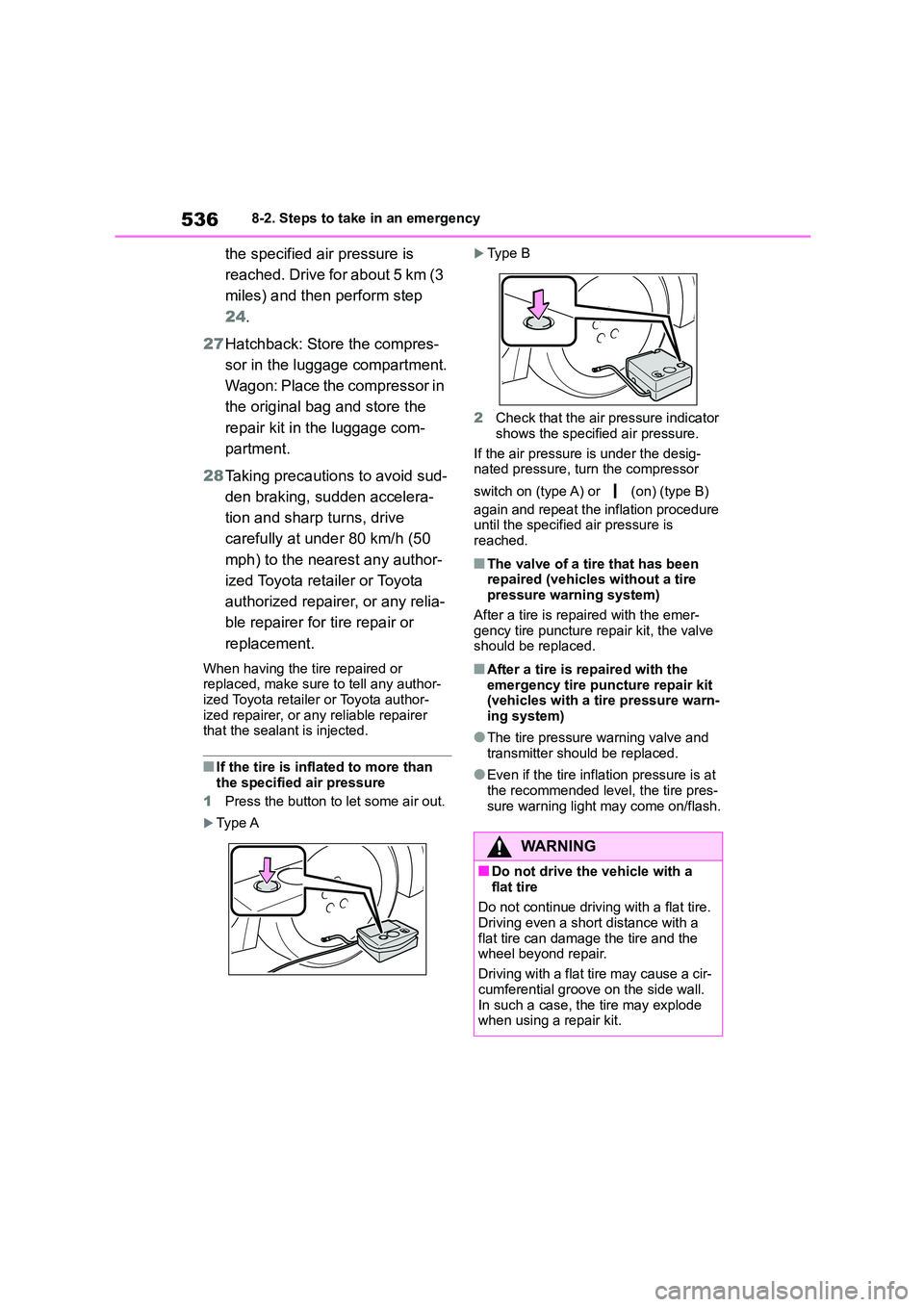
5368-2. Steps to take in an emergency
the specified air pressure is
reached. Drive for about 5 km (3
miles) and then perform step
24 .
27 Hatchback: Store the compres-
sor in the luggage compartment.
Wagon: Place the compressor in
the original bag and store the
repair kit in the luggage com-
partment.
28 Taking precautions to avoid sud-
den braking, sudden accelera-
tion and sharp turns, drive
carefully at under 80 km/h (50
mph) to the nearest any author-
ized Toyota reta iler or Toyota
authorized repairer, or any relia-
ble repairer for tire repair or
replacement.
When having the tire repaired or
replaced, make sure to tell any author-
ized Toyota retailer or Toyota author- ized repairer, or any reliable repairer
that the sealant is injected.
■If the tire is infl ated to more than
the specified air pressure
1 Press the button to let some air out.
Ty p e A
Ty p e B
2 Check that the air pressure indicator
shows the specified air pressure.
If the air pressure is under the desig- nated pressure, turn the compressor
switch on (type A) or (on) (type B)
again and repeat the inflation procedure until the specified air pressure is
reached.
■The valve of a tire that has been
repaired (vehicles without a tire pressure warning system)
After a tire is repaired with the emer-
gency tire puncture repair kit, the valve should be replaced.
■After a tire is repaired with the
emergency tire puncture repair kit
(vehicles with a tire pressure warn- ing system)
●The tire pressure warning valve and transmitter should be replaced.
●Even if the tire inflation pressure is at the recommended level, the tire pres-
sure warning light may come on/flash.
WA R N I N G
■Do not drive the vehicle with a
flat tire
Do not continue driving with a flat tire.
Driving even a short distance with a
flat tire can damage the tire and the wheel beyond repair.
Driving with a flat tire may cause a cir-
cumferential groove on the side wall. In such a case, the tire may explode
when using a repair kit.
Page 539 of 758
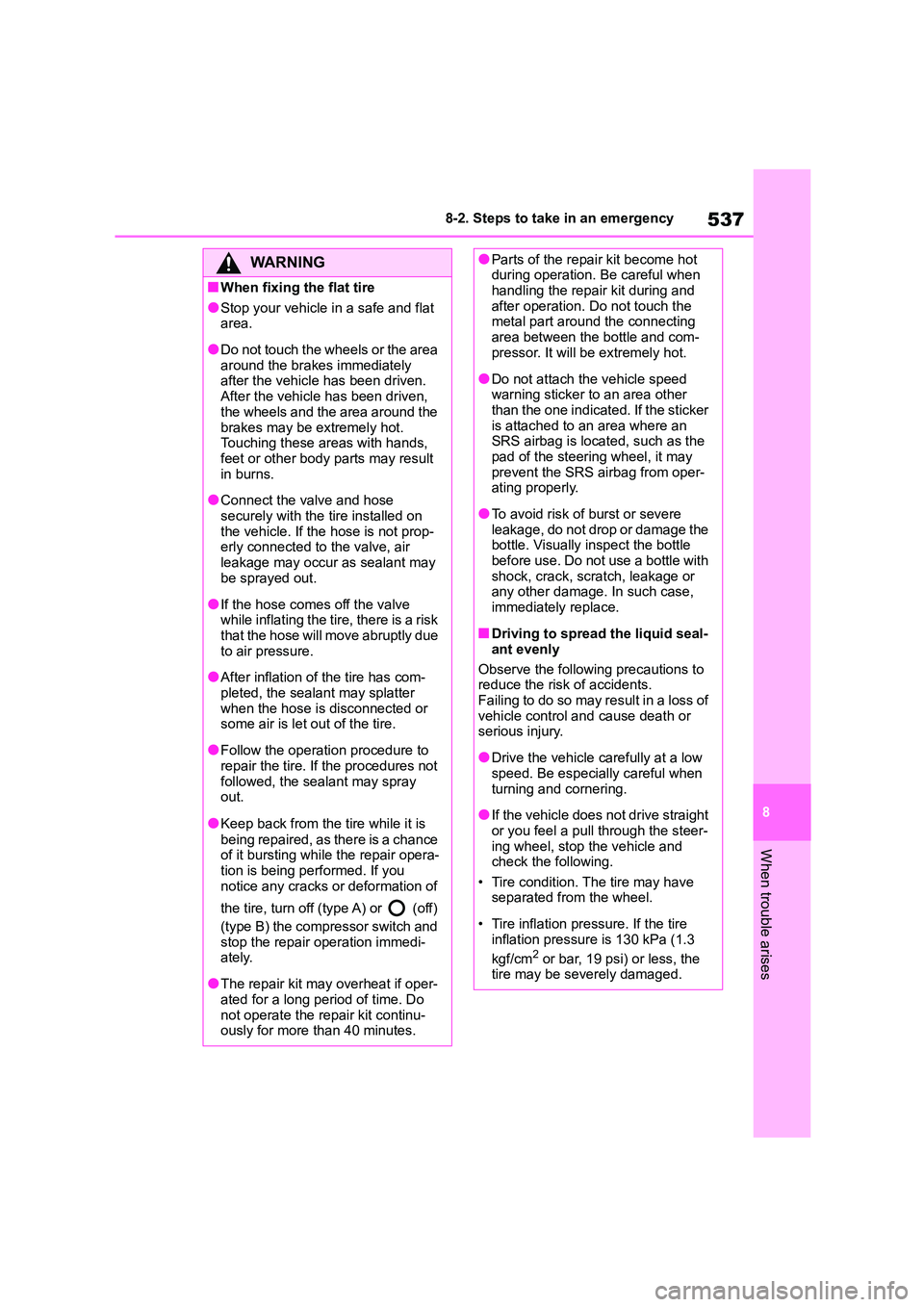
537
8
8-2. Steps to take in an emergency
When trouble arises
WA R N I N G
■When fixing the flat tire
●Stop your vehicle in a safe and flat
area.
●Do not touch the wheels or the area
around the brakes immediately after the vehicle has been driven.
After the vehicle has been driven,
the wheels and the area around the
brakes may be extremely hot. Touching these areas with hands,
feet or other body parts may result
in burns.
●Connect the valve and hose
securely with the tire installed on the vehicle. If the hose is not prop-
erly connected to the valve, air
leakage may occur as sealant may be sprayed out.
●If the hose comes off the valve while inflating the tire, there is a risk
that the hose will move abruptly due
to air pressure.
●After inflation of the tire has com-
pleted, the sealant may splatter when the hose is disconnected or
some air is let out of the tire.
●Follow the operation procedure to
repair the tire. If the procedures not
followed, the sealant may spray out.
●Keep back from the tire while it is
being repaired, as there is a chance of it bursting while the repair opera-
tion is being performed. If you
notice any cracks or deformation of
the tire, turn off (type A) or (off)
(type B) the compressor switch and
stop the repair operation immedi- ately.
●The repair kit may overheat if oper-ated for a long period of time. Do
not operate the repair kit continu-
ously for more than 40 minutes.
●Parts of the repair kit become hot during operation. Be careful when
handling the repair kit during and
after operation. Do not touch the metal part around the connecting
area between the bottle and com-
pressor. It will be extremely hot.
●Do not attach the vehicle speed
warning sticker to an area other than the one indicated. If the sticker
is attached to an area where an
SRS airbag is located, such as the pad of the steering wheel, it may
prevent the SRS airbag from oper-
ating properly.
●To avoid risk of burst or severe
leakage, do not drop or damage the bottle. Visually inspect the bottle
before use. Do not use a bottle with
shock, crack, scratch, leakage or any other damage. In such case,
immediately replace.
■Driving to spread the liquid seal-
ant evenly
Observe the following precautions to reduce the risk of accidents.
Failing to do so may result in a loss of
vehicle control and cause death or serious injury.
●Drive the vehicle carefully at a low speed. Be especially careful when
turning and cornering.
●If the vehicle does not drive straight
or you feel a pull through the steer-
ing wheel, stop the vehicle and check the following.
• Tire condition. The tire may have
separated from the wheel.
• Tire inflation pressure. If the tire
inflation pressure is 130 kPa (1.3
kgf/cm2 or bar, 19 psi) or less, the tire may be severely damaged.
Page 540 of 758
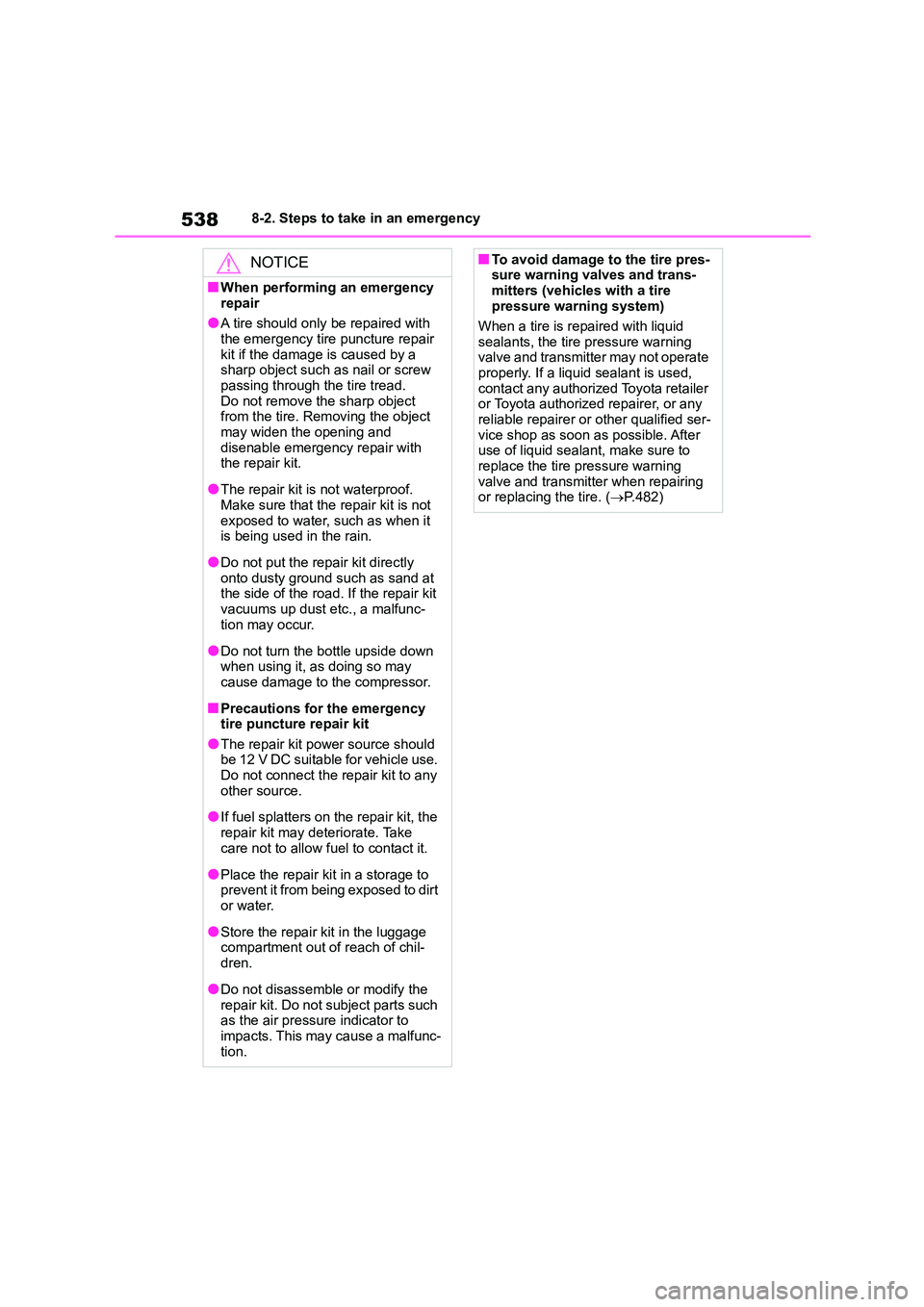
5388-2. Steps to take in an emergency
NOTICE
■When performing an emergency
repair
●A tire should only be repaired with the emergency tire puncture repair
kit if the damage is caused by a
sharp object such as nail or screw passing through the tire tread.
Do not remove the sharp object
from the tire. Removing the object
may widen the opening and disenable emergency repair with
the repair kit.
●The repair kit is not waterproof.
Make sure that the repair kit is not
exposed to water, such as when it is being used in the rain.
●Do not put the repair kit directly onto dusty ground such as sand at
the side of the road. If the repair kit
vacuums up dust etc., a malfunc- tion may occur.
●Do not turn the bottle upside down when using it, as doing so may
cause damage to the compressor.
■Precautions for the emergency
tire puncture repair kit
●The repair kit power source should be 12 V DC suitable for vehicle use.
Do not connect the repair kit to any
other source.
●If fuel splatters on the repair kit, the
repair kit may deteriorate. Take care not to allow fuel to contact it.
●Place the repair kit in a storage to prevent it from being exposed to dirt
or water.
●Store the repair kit in the luggage
compartment out of reach of chil-
dren.
●Do not disassemble or modify the
repair kit. Do not subject parts such as the air pressure indicator to
impacts. This may cause a malfunc-
tion.
■To avoid damage to the tire pres- sure warning valves and trans-
mitters (vehicles with a tire
pressure warning system)
When a tire is repaired with liquid
sealants, the tire pressure warning
valve and transmitter may not operate properly. If a liquid sealant is used,
contact any authorized Toyota retailer
or Toyota authorized repairer, or any reliable repairer or other qualified ser-
vice shop as soon as possible. After
use of liquid sealant, make sure to replace the tire pressure warning
valve and transmitter when repairing
or replacing the tire. ( P.482)